
Cechenena helops is a moth of the family Sphingidae first described by Francis Walker in 1856. It is found in Malaysia, Indonesia, the Philippines, Nepal, north-eastern India, Thailand, south-western China and Vietnam.

Theretra silhetensis, the brown-banded hunter hawkmoth, is a moth of the family Sphingidae described by Francis Walker in 1856. It lives in Indo-Australia, India, Sri Lanka, Papua New Guinea, East Australia, Solomon Islands, Fiji Islands, Vanuatu Islands.

Ptychosperma is a genus of flowering plant in the family Arecaceae. Most are native to Australia and/or New Guinea, with a few in the Solomon Islands and in Maluku Province of eastern Indonesia. Some have been cultivated abroad as house or garden plants, and reportedly naturalized in certain regions

Macroglossum augarra is a moth of the family Sphingidae. It is known from the Bismarck Archipelago and Papua New Guinea.

Macroglossum hirundo is a moth of the family Sphingidae. It is known from the Cook Islands, Fiji, the Society Islands, Australia, Papua New Guinea, the Bismarck Archipelago and the Solomon Islands.
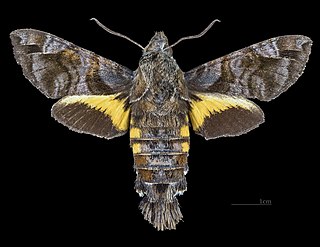
Macroglossum insipida, the hermit hummingbird hawkmoth, is a moth of the family Sphingidae. It was described by Arthur Gardiner Butler in 1875.

Macroglossum tenebrosa is a moth of the family Sphingidae first described by Thomas Pennington Lucas in 1891. It is known from Sulawesi, the Moluccas, Aru, Papua New Guinea, the Bismarck Archipelago, the Solomon Islands and north-eastern Australia.

Theretra is a genus of moths in the family Sphingidae. The genus was established by Jacob Hübner in 1819.
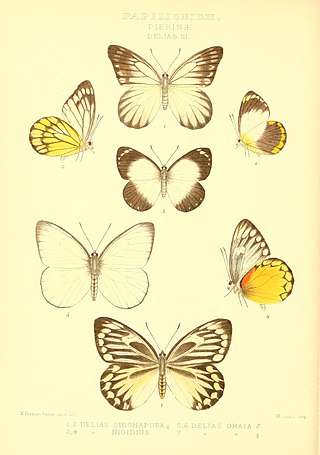
Delias ennia, the yellow-banded Jezebel, is a butterfly in the family Pieridae. It is found in Australia, Indonesia, Papua New Guinea and several surrounding islands.

Pantoporia venilia, the Cape York aeroplane or black-eyed plane, is a butterfly of the family Nymphalidae. It is found in Australia (Queensland), Indonesia, Papua New Guinea and surrounding islands.
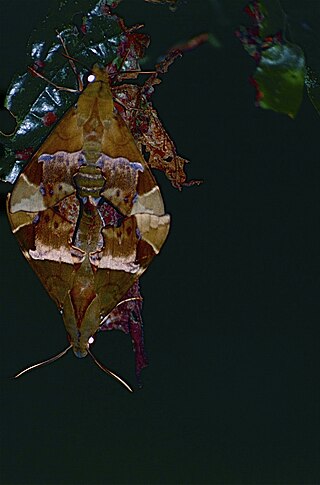
Angonyx papuana is a moth of the family Sphingidae.
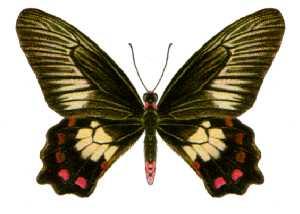
Pachliopta polydorus, the red-bodied swallowtail, is a butterfly from the family Papilionidae found in north-eastern Queensland, Australia and Papua New Guinea.

Theretra queenslandi is a moth of the family Sphingidae first described by Thomas Pennington Lucas in 1891.

Theretra radiosa is a moth of the family Sphingidae.

Theretra insularis is a moth of the family Sphingidae first described by Charles Swinhoe in 1892. It is known from the Philippines, north-eastern Borneo, the Moluccas, Papua New Guinea, the Solomon Islands and Fiji.
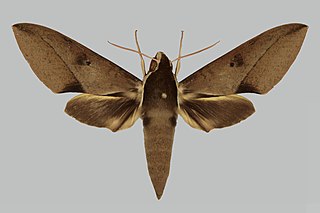
Theretra natashae is a moth of the family Sphingidae. It is found in Indonesia.
Theretra tabubilensis is a moth of the family Sphingidae first described by Robert B. Lachlan in 2009. It is known from New Guinea.
Ambulyx ceramensis is a species of moth in the family Sphingidae. It was described by James John Joicey and George Talbot in 1921 and is known from Indonesia.
Spilarctia holobrunnea is a moth in the family Erebidae. It was described by James John Joicey and George Talbot in 1916. It is found on New Guinea, where it has been recorded from the Arfak Mountains in Papua. It is probably also present in Papua New Guinea.

Tapeinochilos is a group of plants in the Costaceae described as a genus in 1869. It is native to Queensland, Papuasia, and the Indonesian Province of Maluku. Centered in Papua New Guinea, only three of the approximately 16 species occur outside of the country.

















